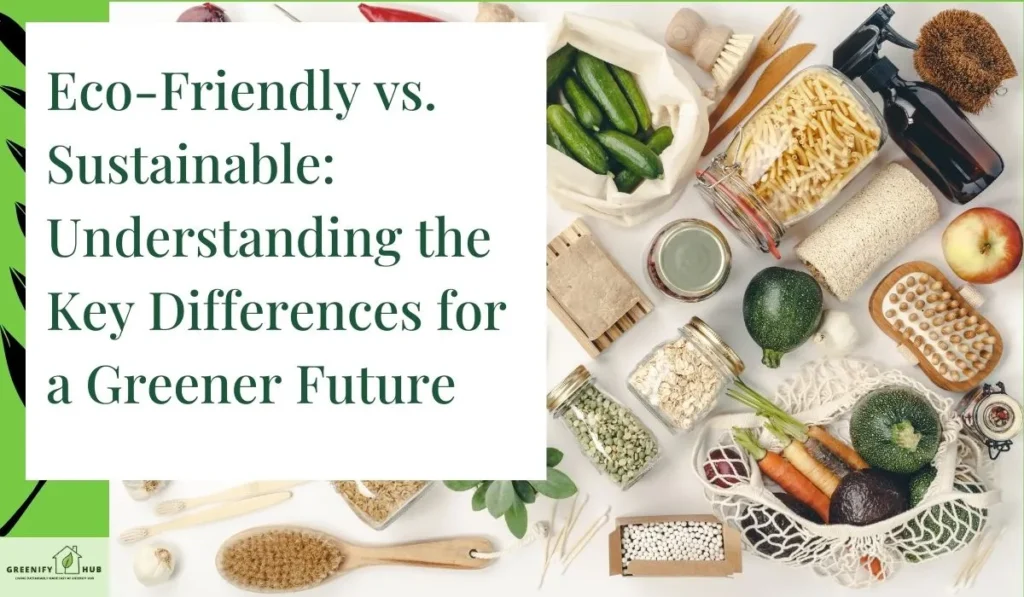Eco Friendly vs Sustainable: Understanding the Key Differences for a Greener Future

Did you know that by 2050, it’s estimated there will be more plastic in the ocean than fish? The choice between eco friendly and sustainable products has never been more critical. Eco-friendly items focus on reducing harm to the environment, while sustainable goods aim to meet present needs without compromising future resources. Understanding the difference between these two concepts is vital for making informed consumer decisions that positively impact the planet.
Defining Sustainability and Eco-Friendly
Sustainability
Sustainability focuses on meeting the needs of the present without compromising the ability of future generations to meet their own needs. It involves using resources in a way that ensures they will still be available for use in the future. Sustainable practices aim to minimize waste, reduce carbon footprint, and protect ecosystems.
Examples of sustainability include using renewable energy sources like solar or wind power, promoting recycling and composting, and supporting fair trade products. These eco-friendly practices emphasize long-term benefits over short-term gains, ensuring that resources are preserved for the well-being of future generations.
Eco-Friendly
Eco-friendly, on the other hand, refers to products or practices that do not harm the environment. It focuses on reducing harm to the environment or ecosystems. Eco-friendly products are designed to have minimal impact on the planet throughout their lifecycle, from production to disposal.
Examples of eco-friendly practices include using biodegradable materials, reducing single-use plastics, and opting for products with minimal packaging. By choosing eco-friendly options, individuals can contribute to reducing pollution levels and protecting natural habitats.
Importance of Long-Term Impacts
When defining sustainability, it is crucial to consider the long-term impacts of our actions on the environment and society. Long-term thinking is essential to ensure that resources are preserved for future generations. By prioritizing sustainability over short-term gains, we can create a more resilient and thriving planet for all living beings.
Pros of Sustainability:
- Ensures resource availability for future generations.
- Reduces environmental degradation.
Cons of Eco-Friendly Practices:
- Higher initial costs may deter some consumers.
- Limited availability of eco-friendly alternatives in certain industries
Key Concepts of Sustainability
Triple Bottom Line
The triple bottom line approach in sustainability considers not only profits (economic sustainability development) but also people (social sustainability) and the planet (environmental aspects). It emphasizes that a business should measure success not just by financial performance but also by its impact on society and the environment.
This approach ensures that companies take into account their social responsibility by considering how their actions affect communities, employees, and other stakeholders. By incorporating social sustainability into their operations, businesses can foster positive relationships with society and contribute to overall well-being.
Balancing Social, Economic, and Environmental Aspects
Sustainability aims to balance social, economic, and environmental aspects to ensure long-term viability. It involves creating a sustainability plan that addresses the needs of the present without compromising the ability of future generations to meet their own needs.
In practice, this means making decisions that not only benefit the company financially (economic sustainability development) but also have positive social and environmental impacts. For example, a company might invest in renewable energy sources to reduce its carbon footprint (environmental aspects) while also implementing fair labor practices to support its workers (social sustainability).
Intergenerational Responsibility
One key aspect of sustainability is intergenerational responsibility, which recognizes that the choices we make today will impact future generations. This principle underscores the importance of sustainable definitions and practices that promote long-term well-being for both current and future populations.
Exploring Eco-Friendly Practices
Various Industries
Industries worldwide are adopting sustainable practices to reduce their environmental impact. From fashion to technology, companies are integrating eco-friendly solutions into their operations. For instance, the fashion industry is embracing sustainable shopping by using organic fabrics and implementing ethical labor practices.
Lifecycle Approach
By studying sustainability, businesses are implementing a lifecycle approach to their products. This involves considering the environmental conservation impact of a product from raw material extraction to disposal. Companies are focusing on sustainable harvesting methods to ensure resources are replenished for future generations.
Packaging Solutions
The use of eco-friendly packaging solutions is gaining momentum due to its positive impact on the environment. Companies are opting for recycled products and biodegradable materials to reduce waste. By choosing environmentally preferable packaging, businesses demonstrate their commitment to environmental responsibility.
Benefits of Eco-Friendly Practices
- Reduced carbon footprint
- Conservation of natural resources
- Improved brand reputation
- Cost savings in the long run
Importance of Sustainable Initiatives
Sustainable initiatives not only benefit the environment but also contribute to a company’s bottom line. By implementing environmental policies, organizations can enhance their environmental performance and attract environmentally conscious consumers.
Examples of Eco-Friendly Products
- Eco-friendly razors made from sustainable materials
- Household cleaning products that are safe for the environment
Sustainability vs Eco-Friendly
Scope Comparison
Sustainability encompasses a broader perspective, focusing on long-term solutions to environmental, social, and economic challenges. It involves making choices that meet present needs without compromising future generations’ ability to meet their own needs. Eco-friendly practices, on the other hand, are more specific, targeting actions that minimize harm to the environment.
By considering the lifecycle of products from production to disposal, sustainability aims for a holistic approach that addresses various aspects like resource conservation, social equity, and economic viability. In contrast, eco-friendly initiatives concentrate on reducing immediate environmental impact through practices like recycling, using renewable energy sources, or minimizing waste generation.
Real-World Examples
Sustainability is exemplified by companies like Patagonia, known for its commitment to using organic cotton and recycled materials in their clothing line. They also promote fair labor practices and donate a percentage of their profits to environmental causes. This demonstrates a comprehensive approach that goes beyond just eco-friendly materials.
Conversely, eco-friendly actions can be seen in initiatives like plastic straw bans in restaurants or the promotion of reusable shopping bags. While these actions contribute to reducing single-use plastics and waste, they represent a smaller aspect of the larger sustainability picture.
Impact Assessment
Pros:
- Sustainable practices lead to long-lasting positive impacts on the environment, society, and economy.
- Eco-friendly initiatives raise awareness and encourage individuals and businesses to adopt greener habits.
Cons:
- Implementing sustainable practices may require significant initial investments or changes in existing systems.
- The term “eco-friendly” can sometimes be used loosely without clear definitions or regulations.
Shopping with a Green Lens
Identifying Green Products
When shopping, focus on products made from sustainable materials that have a minimal impact on the planet. Look for items that are eco-friendly and contribute positively to the environment.
Consider the triple bottom line of products – their impact on the planet, people, and profits. Opt for goods that align with these principles to ensure they are truly green.
Making Environmentally Conscious Choices
Prioritize products that are produced through ethical practices and do not cause harm to the environment. Choose items that meet your needs while also supporting sustainability efforts.
Look for certifications such as the Forest Stewardship Council (FSC) or Fair Trade labels, indicating that the product meets specific environmental and social standards. These labels help in identifying genuinely green products.
Tips for Sustainable Shopping
- Research: Before making a purchase, conduct research on brands and their sustainability initiatives.
- Quality Over Quantity: Invest in durable products that last longer, reducing the need for frequent replacements.
- Minimal Packaging: Choose items with minimal or recyclable packaging to reduce waste.
- Second-Hand Shopping: Consider buying second-hand or vintage items to reduce the demand for new production.
- Support Local: Purchase from local businesses to reduce carbon emissions associated with transportation.
Avoiding Greenwashing
Detecting Greenwashing
Greenwashing is the deceptive practice of promoting environmentally friendly products or initiatives to higher standards than they truly meet. This can damage the credibility of both eco-friendly and sustainable movements. Consumers may be misled into supporting companies that claim to be environmentally conscious but actually engage in harmful practices.
To detect greenwashing, consumers should look out for key indicators such as vague language, lack of third-party certifications, and exaggerated claims. By scrutinizing labels and marketing materials, individuals can make more informed choices and avoid falling for misleading tactics.
Strategies to Avoid Greenwashing
One effective strategy to avoid greenwashing is to conduct thorough research on brands and products. Consumers can cross-reference information from multiple sources, including independent reviews and environmental organizations’ assessments. Choosing products with recognized certifications such as USDA Organic or Fair Trade can help ensure authenticity.
Another approach is to prioritize companies that demonstrate transparency in their sustainability efforts. Brands that openly share information about their supply chains, manufacturing processes, and environmental impact are more likely to be genuine in their commitment to eco-friendliness. By supporting transparent businesses, consumers can contribute to positive environmental change.
Importance of Transparency in Green Marketing
Transparency plays a crucial role in fostering trust between consumers and brands in the realm of green marketing. When companies are upfront about their practices and disclose relevant information, it builds credibility and establishes a sense of accountability. Transparent communication helps consumers make informed decisions based on accurate data rather than misleading claims.
Certifying True Green Efforts
Reputable Certifications
Reputable green certifications play a crucial role in distinguishing between eco-friendly and sustainable products. Look for labels such as “Energy Star,” “Fair Trade Certified,” or “USDA Organic” to ensure authenticity.
Certifications like LEED (Leadership in Energy and Environmental Design) focus on sustainable building practices, while the Forest Stewardship Council (FSC) ensures responsible forest management. These certifications guarantee that products meet specific environmental standards.
Validating Claims
Certifications act as third-party verification, confirming that companies adhere to strict environmental guidelines. They prevent greenwashing by holding businesses accountable for their sustainability claims.
Consumers can trust products with certifications from organizations like the Rainforest Alliance or Cradle to Cradle. These labels certify that items are produced sustainably, promoting ethical practices and environmental stewardship.
Leveraging Certifications
Consumers can empower themselves by understanding the significance of various green certifications. By choosing products with recognized labels, they support companies making genuine efforts towards sustainability.
When shopping, look for certifications that align with your values, such as the Global Organic Textile Standard (GOTS) for organic textiles or the Marine Stewardship Council (MSC) for sustainable seafood. These labels guide consumers towards environmentally friendly choices.
Future of Green Practices
Trends
Innovative technologies are revolutionizing eco-friendly and sustainable practices. Companies are increasingly embracing renewable energy sources to reduce their carbon footprint. The shift towards sustainable supply chains is gaining momentum, promoting ethical sourcing and reducing environmental impact.
Innovations
Cutting-edge solutions such as vertical farming and water-saving irrigation systems are transforming agriculture. In the construction industry, the adoption of green building materials like recycled steel and bamboo is on the rise. Moreover, advancements in energy-efficient appliances are enhancing sustainability in households.
Continuous Improvement
Continuous improvement is crucial for the long-term success of green initiatives. Regular assessments of environmental impact and implementation of corrective measures are essential. Companies must prioritize employee training on sustainable practices to ensure ongoing compliance with green standards.
Summary
You now grasp the distinction between eco friendly and sustainable practices. By understanding the core concepts of sustainability and eco-friendliness, you can make informed choices. Shopping with a green lens and avoiding greenwashing will empower you to support genuine green efforts. Certifying true green practices ensures your actions align with your values. The future of green practices lies in your hands; each decision impacts our environment.
Take action by incorporating sustainable practices into your daily life. Support businesses that prioritize eco-friendly initiatives and hold them accountable for their environmental claims. Embrace a sustainable mindset to create a greener future for generations to come.





